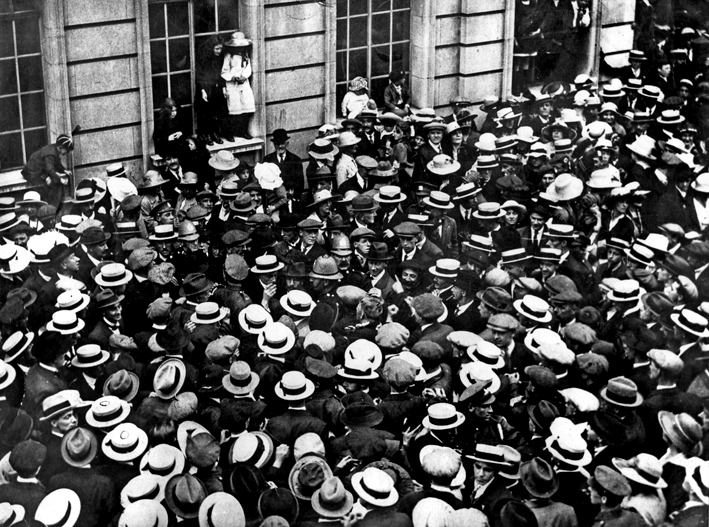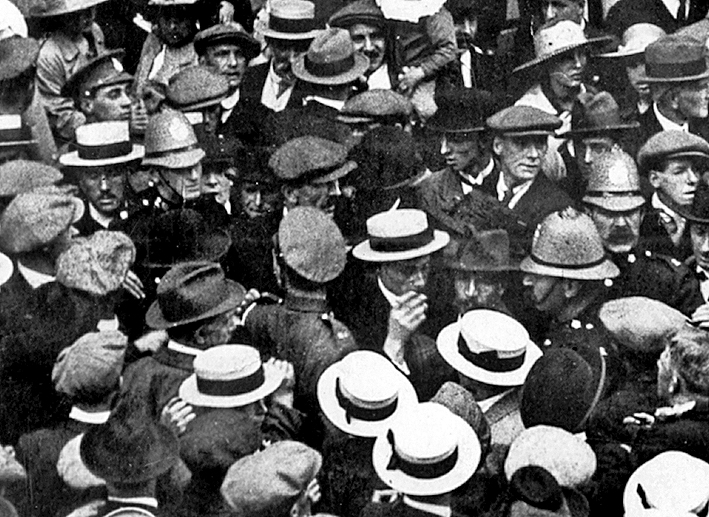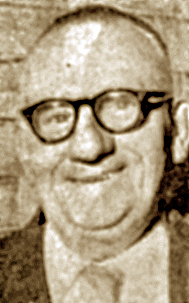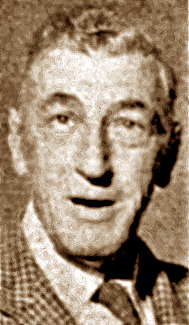
- The Peace Day riot picture that evoked memories 42 years later.

- Pc Sear, Pc Higham and Sgt Matsell among the crowd.
Some 42 years after the infamous day when rioters burned down Luton Town Hall during Peace Day celebrations on July 19th, 1919, The Luton News interviewed two of the then young police officers who had been on duty for their recollections. Here is their story as published in 1961.
On that momentous afternoon two young policemen, one aged 23 and the other 21, pushed their way through a packed crowd in the direction of some shouting. With them a moustached police sergeant struggled through the mass of people. A steady drumming of shouting, laughing and talking filled George Street and Williamson Street as a photographer sighted the scene and pressed the bulb of his camera.
The picture he took, now yellow with age, was published in The Luton News last week under the title, Mystery of the Boater Age. But for many Lutonians it was no mystery, rather a thing best forgotten - it was July 19th, 1919.
On that day and the next this quiet Bedfordshire town went mad. Hundreds rioted in the streets, troops were called in, the Town Hall was gutted by fire and the hospital and jail were full. Many remember that tension-charged afternoon as the riot started, two constables in particular.
 Thomas Higham (pictured right, top), of 35 Bosmore Road, had been in the Luton Borough Police Force since March of that year. He was aged 21. Like him, Albert Sear, of 70 Beechwood Road, Luton had fought in the Great War in the dusty heat of the Middle East. For Mr Sear, then 23, it was his first day in uniform. Both were on patrol with Sgt Jack Matsell when the trouble flared.
Thomas Higham (pictured right, top), of 35 Bosmore Road, had been in the Luton Borough Police Force since March of that year. He was aged 21. Like him, Albert Sear, of 70 Beechwood Road, Luton had fought in the Great War in the dusty heat of the Middle East. For Mr Sear, then 23, it was his first day in uniform. Both were on patrol with Sgt Jack Matsell when the trouble flared.
Recalling the day, Mr Higham, at 65, a commissionaire with a Luton hat manufacturer, said: "George Street was full. The crowd filled Bedford Road right down to Wardown Park and all round the vicinity of the town centre. They were all waiting to see what would happen. Everyone knew there was going to be something.
"I was new to Luton and didn't know half the people. When the photograph was taken I was talking to an agitator. I asked him to behave."
Mr Higham and Albert Sear were both injured in the rioting that came later in the evening.
"I didn't worry too much about the crowd at that time," he said. "I was too busy to think about what was happening. I got knocked out later."
At Luton Hoo, where Mr Sear is now chief security officer, the retired police superintendent looked at the photograph and said: "Yes, I remember, but I'm very surprised you dug it up. I should have thought you'd want to let it lie.
"When the picture was taken I had become a little bit isolated, and I think they (Pc Higham and P Sgt Matsell) were trying to get through to me. Later in the afternoon I was among the chaps who cleared the Town Hall."
 Mr Sear (pictured right, below) said part of the trouble that day was the impossibility of getting any police support from neighbouring areas. Peace Day celebrations were being held throughout the country.
Mr Sear (pictured right, below) said part of the trouble that day was the impossibility of getting any police support from neighbouring areas. Peace Day celebrations were being held throughout the country.
Like the other policemen, he too was wearing the light-weight, if easily collapsible, straw helmet of the age. During the night his head was battered and an ear cut.
A confused series of events led up to the disturbances on Saturday night. Involved was the question of where to hold a memorial service and the Council's refusal of Wardown Park. Also there was general unrest among veterans combined with the excitement of the national Peace Day celebrations.
Cuttings from The Luton News after the riot tell the grim story.
The time is early afternoon July 19th, 1919. The place is George Street, Luton.
"A procession led by a detachment representing the Comrades of the Great War headed the column. A halt was called in front of the Town Hall.
"The Mayor [Councillor Henry Impey], wearing his robes and chain of office came to the edge of the pavement and proceeded to read the King's Peace Proclamation, and briefly to address the discharged men. His appearance was the signal for a hostile demonstration on the part of the crowd, cheering being turned into jeering.
"The attitude of the crowd a little later assumed a distinctly ugly character, and as a precautionary measure Sgt Matsell and three constables took up a position on the steps. There were loud cries for the Mayor, and a section of the spectators advanced and demanded that his Worship and the Town Clerk should come to the front and give explanations of the Corporation's decision in regard to Wardown. The request was not acceded to, and a move was made in the direction of the doors.
"For quite a time Sgt Matsell and his police colleagues, though hustled considerably, held their ground. Finally, overpowered by sheer weight of numbers, the police were rushed and the doors forced open.
"The object of the crowd which screamed into the building seemed to be the assembly room in which Monday night's banquet was to be held. Immediately they commenced to wreck the furniture, and a suggestion was made that the whole of the tables and chairs should be thrown through the windows into the street. Chairs were pitched on to the pavement below, some windows being broken in the process, while a missile of some kind was hurled through the Town Clerk's office.
"At this point the police exhorted the men to remember the innocent women and children in the crowd below who stood in danger of serious injury from falling furniture.
"Intruders then got on to the balcony and proceeded to tear down all the bunting and decorations as well as the framework of the electrical illuminations scheme erected the previous day. With reinforcements the police eventually cleared the hall."
It was after these incidents that the photograph showing the police in the crowd was taken. Mr Higham has placed the time at somewhere between 3pm and 4pm.
After cooling off during the late afternoon, the excitement grew later in the evening. Then the pubs closed.
The Luton News takes up the story thus: "Between 10pm and 11pm a large and determined mob arrived to swell the already congested Town Hall approaches, armed with bricks, hammers and other weapons. There was a good deal of noise but no real attempt at damage appears to have been made until the light of the Dover flares at each end of the town - People's Park, Hart Hill, London Road and the back of the Downs - lit the whole district as though by day.
"Immediately, as though by a pre-arranged signal, a fusilade of bricks and other missiles was rained upon the Town Hall, and the windows smashed with great rapidity.
"By this time a full-scale riot was in progress. Windows were smashed and the Town Hall set alight with petrol from a nearby shop. Pitched fights broke out with the police. Shops were looted and the horses of mounted officers attacked with knives. Hoses of firemen trying to control the blaze were cut and the men mauled. Fantastic scenes of bedlam followed as chopped hoses were turned on the crowd, sweeping people off their feet.
"Flames leapt high in the shy. By three o'clock troops with steel helmets and fixed bayonets patrolled the street.
"The major part of the riot was over. But for a lot of Lutonians the memory of that awful night remains fixed in their minds. They remember the afternoon the picture in The Luton News was taken - the afternoon of the night a town went mad."
[Pc Albert Joseph Sear served from May 5th, 1919, to March 31st, 1947, in the Luton Borough Force, rising to Deputy Chief Constable, and then to February 18th, 1949, in the Beds County Force as a Superintendent. Thomas Higham served as a constable in the Borough force from March 24th, 1919, to June 4th, 1946. Sgt John Matsell served in the Luton Borough Force from May 15th, 1900, to September 2nd, 1927. Source: The Men Who Wore Straw Helmets by T. J. Madigan.]
[The Luton News: September 21st, 1961]

